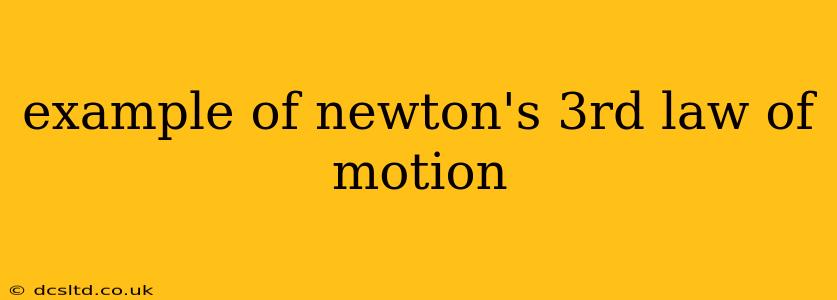Newton's Third Law of Motion, often simplified to "for every action, there's an equal and opposite reaction," is a fundamental principle in physics governing how objects interact. Understanding this law requires recognizing that forces always come in pairs. Let's explore several compelling examples to illustrate this crucial concept.
What are Action and Reaction Forces?
Before diving into examples, it's vital to clarify the nature of action-reaction pairs. They are not two forces acting on the same object. Instead, they are two forces acting on different objects. The forces are equal in magnitude (strength) and opposite in direction, but they affect different objects, leading to different outcomes.
Everyday Examples of Newton's 3rd Law
Here are some everyday instances showcasing Newton's Third Law:
1. Walking
When you walk, you push backward on the ground (action). The ground, in turn, pushes forward on your feet with an equal and opposite force (reaction). This forward force propels you forward. Without the ground's reaction force, you wouldn't be able to move.
2. Swimming
Similar to walking, swimming involves pushing water backward (action). The water then exerts an equal and opposite force forward on your body (reaction), propelling you through the water.
3. Jumping
When you jump, you exert a downward force on the Earth (action). Simultaneously, the Earth exerts an upward force on you (reaction), causing you to leave the ground. While the force on the Earth is equal to the force on you, the Earth's immense mass means its acceleration is negligible, unlike your own significant acceleration upwards.
4. Rocket Launch
A rocket engine expels hot gas downward (action). This downward expulsion of gas creates an equal and opposite upward force on the rocket (reaction), pushing it skyward.
5. Hitting a Baseball
When a baseball bat strikes a ball, the bat exerts a force on the ball (action), causing it to accelerate. Simultaneously, the ball exerts an equal and opposite force on the bat (reaction), which you feel as a slight recoil or "sting" in your hands.
6. Sitting on a Chair
When you sit on a chair, you exert a downward force on the chair (action) due to gravity. The chair, in turn, exerts an upward force on you (reaction), preventing you from falling to the ground.
Frequently Asked Questions (FAQs)
Here are some common questions regarding Newton's Third Law, answered to provide a clearer understanding:
How can the forces be equal if the outcomes are different?
The key is understanding that the forces act on different objects with different masses. While the forces are equal in magnitude, the resulting acceleration differs because acceleration is inversely proportional to mass (Newton's Second Law: F=ma). A smaller mass (like you jumping) experiences a greater acceleration than a much larger mass (like the Earth).
Does Newton's Third Law apply to all forces?
Yes, Newton's Third Law applies to all forces, including gravitational, electromagnetic, and strong and weak nuclear forces. Every interaction involves a pair of equal and opposite forces acting on different objects.
Are action and reaction forces always simultaneous?
Yes, action and reaction forces always occur simultaneously. They are inseparable parts of a single interaction.
Can you give a more complex example of Newton's 3rd Law?
Consider a collision between two cars. Car A exerts a force on Car B (action), causing a deformation and change in motion. Simultaneously, Car B exerts an equal and opposite force on Car A (reaction), also resulting in deformation and a change in its motion. The severity of damage to each car will depend on factors like speed, mass and the material properties of the vehicles.
By exploring these varied examples and addressing common questions, we hope to provide a comprehensive understanding of Newton's Third Law of Motion and its pervasive influence on the physical world.
